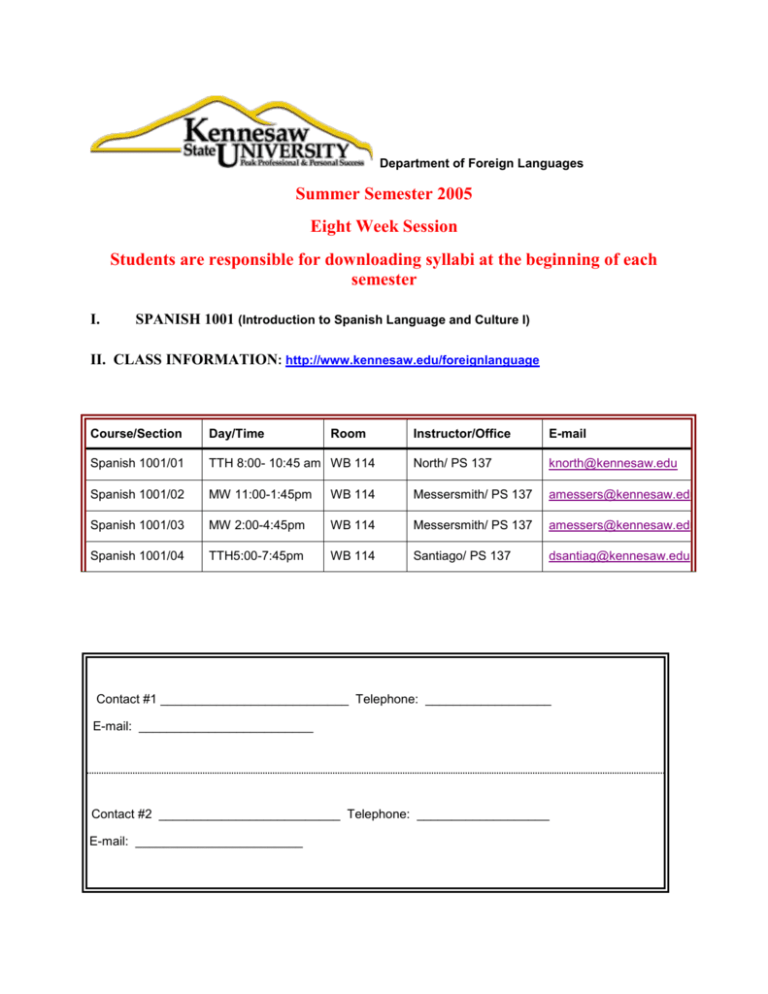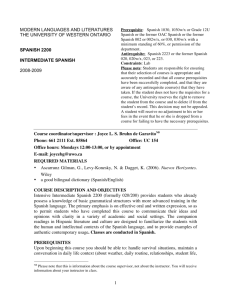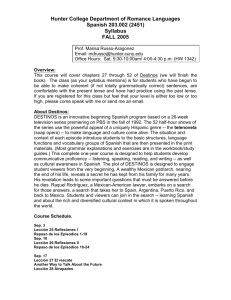span1001-su05 - Kennesaw State University
advertisement

Department of Foreign Languages Summer Semester 2005 Eight Week Session Students are responsible for downloading syllabi at the beginning of each semester I. SPANISH 1001 (Introduction to Spanish Language and Culture I) II. CLASS INFORMATION: http://www.kennesaw.edu/foreignlanguage Course/Section Day/Time Spanish 1001/01 Room Instructor/Office E-mail TTH 8:00- 10:45 am WB 114 North/ PS 137 knorth@kennesaw.edu Spanish 1001/02 MW 11:00-1:45pm WB 114 Messersmith/ PS 137 amessers@kennesaw.edu Spanish 1001/03 MW 2:00-4:45pm WB 114 Messersmith/ PS 137 amessers@kennesaw.edu Spanish 1001/04 TTH5:00-7:45pm WB 114 Santiago/ PS 137 dsantiag@kennesaw.edu Contact #1 ___________________________ Telephone: __________________ E-mail: _________________________ Contact #2 __________________________ Telephone: ___________________ E-mail: ________________________ III. TEXTS 1. Blanco, et al. VISTAS. 2nd Edition Introducción a la lengua española. 2. QUIA Second Edition Web-SAM 3. Student CDs to accompany VISTAS 4. II. Pocket dictionary/language guide IV. CATALOG DESCRIPTION: Prerequisite: ENGL 0099 and READ 0099, if required. Introduction to Spanish language and culture, stressing progressive acquisition of effective communication skills in both the written and spoken language and an understanding of the practices and products of Hispanic cultures. Not open to native speakers of Spanish. V. TENTATIVE SCHEDULE (subject to change as necessary) June 1 - 2 Lección 1 June 6 - 9 Lección 1 June 13 - 16 Lección 2 June 20 - 22 Lección 2 & test 1 Lección 3 June 27 - 29 Lección 3 June 29 Last day to drop without penalty July 2 - 4 HOLIDAY July 5 - 7 Lección 4 July 11 – 13 Lección 4, & Test 2 Lección 5 July 18 - 21 Lección 5 July 25 - 26 Last day of classes July 28 – 29 Final exam Oral Presentations LAST DAY TO DROP WITHOUT ACADEMIC PENALTY: June 29, 2005. FINAL EXAMINATION: Will include six sections, one each for listening, speaking, reading, writing, grammar and culture. DATE OF EXAMINATION: Spanish 1001/01: July 28, 2005 from 9:00 a.m. to 11:00 a.m. in WB 114 Spanish 1001/02: July 27, 2005 from 11:30 a.m. to 1:30 p.m. in WB 114 Spanish 1001/03: July 27, 2005 from 2:00 p.m. to 4:00 p.m. in WB 114 Spanish 1001/04: July 28, 2005 from 5:oo p.m. to 7:00 p.m. in WB 114 Failure to take the final exam at the time, date and place scheduled will result in a final grade of "F." Exceptions to this policy must be requested in writing by the student, endorsed in writing by the instructor, and approved, in writing, by Department Chair. Requests must be submitted two weeks prior to the end of the current semester. VI. COURSE GOALS: In this course students develop effective communication skills in Spanish appropriate to this stage of language study and expand their knowledge of language and culture. VII. GENERAL EXPECTATIONS: Students are expected to attend all classes, to arrive on time and to remain in class for the entire two hours and forty-five minutes. There are no "excused" absences; for each absence in excess of one, one point will be deducted from the student's final grade average. In other words, a student may miss one class meeting without penalty. If a student is habitually late, the instructor reserves the right to determine if a tardy constitutes an absence. Students are expected to maintain classroom decorum. Any behavior deemed disruptive by the instructor will result in your being asked to leave class. Such an event is an unexcused absence and the student may be referred to the dean of students for further action. (http://www.kennesaw.edu/judiciary/code.conduct.shtml) . Classes will start on time. If for some reason you find it necessary to arrive late, you will be responsible for all information, including announcements, changes in syllabus, etc. If you are absent, you are also responsible for all assignments and other announcements made during the class meeting. You are, therefore, strongly advised to ask another student for his/her email address and telephone number. Class time will be used to develop all four basic skills (listening comprehension, speaking, reading comprehension, and writing) and culture. However, a special emphasis will be put on speaking. You are expected to study and practice at home as part of your daily preparation. Tutors are also available in the Foreign Language Resource Center (Pilcher Bldg) at no charge to the student. All assignments, whether written or oral, are to be finished by the time class begins. No late homework will be accepted. Emergencies will be handled on an individual basis. No make-up tests or assignments will be given. A grade of "0" will be assigned for all work not turned in or any tests not taken. There will be no "extra credit." Emergencies will be handled on an individual basis. Turn OFF all cell phones, beepers, pagers and any other potentially disruptive noise makers when you arrive in class. VIII. GENERAL POLICIES: (1) Academic Integrity: Every KSU student is responsible for upholding the provisions of the Student Code of Conduct, as published in the Undergraduate and Graduate Catalogs. Section II of the Student Code of Conduct addresses the University's policy on academic honesty, including provisions regarding plagiarism and cheating, unauthorized access to University materials, misrepresentation/ falsification of University records or academic work, malicious removal, retention, or destruction of library materials, malicious/intentional misuse of computer facilities and/or services, and misuse of student identification cards. Incidents of alleged academic misconduct will be handled through the established procedures of the University Judiciary Program, which includes either an "informal" resolution by a faculty member, resulting in a grade adjustment, or a formal hearing procedure, which may subject a student to the Code of Conduct's minimum one semester suspension requirement. The Department of Foreign Languages at Kennesaw State University considers it a breach of academic integrity for the student to use automatic translators of any kind to complete an assignment. Furthermore, no compositions or other work should be written or edited for the student by a native speaker of the target language, by a tutor or student assistant in the Foreign Language Resource Center, or by any other individual. (2) Disability policy: Kennesaw State University provides program accessibility and reasonable accommodations for persons identified as disabled under Section 504 of the Rehabilitation Act of 1973 or the Americans with Disabilities Act of 1990. A number of services are available to help disabled students with their academic work. In order to make arrangements for special services, students must visit the Office of Disabled Student Support Services (770/423-6443) and arrange an individual assistance plan. In some cases, certification of disability is required. IX. COURSE GOALS: X. STUDENT LEARNING OUTCOMES: In this course students develop effective communication skills in Spanish appropriate to this stage of language study and expand their knowledge of language and culture. This course will contribute to the candidates’ attainment of the following general (GSLO) and specific (SSLO) student learning outcomes of the B.A. in Modern Language & Culture (ML&C): STANDARD 1: LANGUAGE, LINGUISTICS, COMPARISONS GSLO 1.a.: Demonstrating Language Proficiency. Candidates demonstrate a high level of proficiency in the target language, and they seek opportunities to strengthen their proficiency. (Skills) SSLO 1.1 a Interpersonal Communication (Speaking) Students participate actively in most informal and some formal conversations dealing with topics related to school, home, and leisure activities, and to a lesser degree, those related to events of work, current, public, and personal interest; they narrate and describe in present, past, and future time frames, but control of aspect may be lacking at times; they combine and link sentences into connected discourse of paragraph length; they handle appropriately a routine situation or familiar communicative task that presents a complication or unexpected turn of events; they are understood by native speakers unaccustomed to dealing with non-natives, even though this may be achieved only through repetition and restatement. (Skills) SSLO 1.2 a Interpretive Communication (Listening & Reading) As listeners, learners move beyond literal comprehension, infer the meaning of unfamiliar words and phrases in new contexts, infer and interpret the author’s intent, and offer a personal interpretation of the message (Skills) As readers, learners move beyond literal comprehension, infer the meaning of unfamiliar words and phrases in new contexts, infer and interpret the author’s intent, and offer a personal interpretation of text. (Skills) SSLO 1.3 a Presentational Communication (Speaking) Learners deliver oral presentations extemporaneously, without reading notes verbatim. Presentations consist of familiar literary and cultural topics and those of personal interest. They speak in connected discourse using a variety of time frames and vocabulary appropriate to the topic. They use extralinguistic support audience comprehension (e.g., visuals). (Skills) SSLO 1.4.a Interpersonal and Presentational Communication (Writing) Learners write about familiar topics by means of narratives, descriptions and summaries of a factual nature in major time frames with some control of aspect; they combine sentences in texts of paragraph length; they incorporate a limited number of cohesive devices; their writing demonstrates control of simple target-language sentence structures and partial control of more complex syntactic structures; their writing is understood by readers accustomed to the writing of second language learners although additional effort may be required in reading the text. (Skills) GSLO 1.b.: Understanding Linguistics. Candidates know the linguistic elements of the target language system, recognize the changing nature of language, and accommodate for gaps in their own knowledge of the target language system by learning on their own. (Knowledge, Attitudes) SSLO 1.2.b Morphology Learners identify morphemes (affixes and stems) in the target language and describe how they are put together to form words. They recognize the meaning of new words by using morphological clues (e.g., word families). (Knowledge) SSLO 1.3.b Syntax Learners describe syntactic patterns of the target language, such as formation of simple sentences and questions, and contrast them with those of their native languages. Learners recognize key cohesive devices used in connected discourse (e.g., conjunctions, adverbs). (Knowledge) SSLO 1.4.b Semantics Learners understand the inferred meaning of words and sentences as well as highfrequency idiomatic expressions. Learners understand and identify semantic differences between their native languages and the target language. (Knowledge) SSLO 1.5.b Rules for word and sentence formation Learners explain the rules that govern the formation of words and sentences such as those pertaining to the verbal system, agreement, use of pronouns, prepositions and postpositions, word order and interrogatives in terms of regularities and irregularities. They exemplify these rules with target language examples. (Knowledge) SSLO 1.6.b Discourse, socio-linguistic, and pragmatic knowledge Learners identify the pragmatic and sociolinguistic features (e.g. politeness conventions, formal/informal forms of address) of target language discourse. They identify target language features for creating coherence in extended spoken and printed texts. (Knowledge) STANDARD 2: CULTURES, LITERATURES, CROSS-DISCIPLINARY CONCEPTS GSLO 2.a. Demonstrating Understanding of Literary and Cultural Texts and Traditions. Learners recognize the value and role of literary and cultural texts and use them to interpret and reflect upon the perspectives of the target cultures over time. (Knowledge, Attitudes) SSLO 2.1.a. Cultural knowledge Learners cite key cultural perspectives and provide support through description of products and practices. (Knowledge) GSLO 2.b. Demonstrating Cultural Understandings. Learners demonstrate that they understand the connections among the perspectives of a culture and its practices and products. (Knowledge) SSLO 2.1.b Knowledge of literary and cultural texts Learners interpret literary texts that represent defining works in the target cultures. They identify themes, authors, historical style, and text types in a variety of media that the cultures deem important in understanding the traditions of the cultures. (Knowledge) Grammar points to be stressed during this semester: 1. Present tense 2. Present progressive 3. Articles (definite and indefinite) 4. Possessive adjectives 5. Stem changing verbs 6. Direct object nouns and pronouns 7. Interrogative expressions Criteria for evaluation of speaking: The objective is for the student to communicate a comprehensible spoken message. The question the instructor must answer is: does the message the student is attempting to communicate make sense? These criteria are designed to help determine the comprehensibility of the student's message. Fluency (is the delivery so slow and halting that it interferes with comprehension, or is it beginning to be smoother and more like normal speech even though utterances may be quite brief?) Pronunciation (is pronunciation accurate enough so as not to interfere with comprehension by an individual accustomed to dealing with non-native speakers of Spanish?) Accuracy (although speech may not be error free, is it correct enough to make sense, to be understood by individuals accustomed to dealing with non-native speakers of Spanish?) Elements to be considered under the category "accuracy" are control of verb tenses appropriate to this level and comprehensibility. Speech that interferes with comprehensibility of the message should be penalized. Vocabulary (is it appropriate for this level and is the student able to use it in context?) Creativity (is the student beginning to be able to depart from textbook vocabulary, phrases and mostly memorized material in order to demonstrate an emerging ability to engage in meaningful conversation, express feelings and emotions, and to present information accurately to a degree appropriate for this level of study?) Criteria for evaluation of writing: The objective is for the student to communicate a comprehensible written message. The question the instructor must answer is: does the message the student is attempting to communicate make sense? These criteria are designed to help determine the overall comprehensibility of the student's message. Content (is the argument, or content, clearly defined? Are ideas connected, clearly presented in a logical, straightforward manner and supported by examples where appropriate?) Organization (does the writing sample present ideas and a conclusion in a logical sequence that clearly indicates how one idea leads to the next? Are transitional devices used appropriately for this level of study? In other words, does the writing sample have a clearly stated theme, perhaps even a thesis statement, as well as a beginning, middle and end?) Vocabulary (does the student demonstrate appropriate use of vocabulary in context for this level of language learning?) Accuracy (does the student demonstrate an appropriate use of grammar at this level of language learning?) Creativity (is the student able to depart from textbook vocabulary, phrases and mostly memorized material in order to demonstrate an emerging ability to engage in meaningful conversation, express feelings and emotions, and to present information accurately? XI. FINAL GRADE: There are 485 possible points to be earned in the course. They are distributed as follows: Two (2) major tests (written and aural/oral) @ 100 pts each 200 One (1) final examination (written and aural/oral) 100 Three (3) compositions @ 20 pts each 60 One (1) oral in-class presentation 25 Other assignments to be determined by the instructor 100 TOTAL POINTS 485 Grading Scale: 100-90%=A; 89-80%=B; 79-70%=C; 69-60%=D; 59% and below=F REMINDER: All tests are cumulative, i.e. they cover all material discussed to date. Students are responsible for all announcements and assignments made in class, even if not listed on the syllabus. Students must find out if any announcements or assignments were made in class during their absences. Assignments may not be made up. There are no make-up tests.









